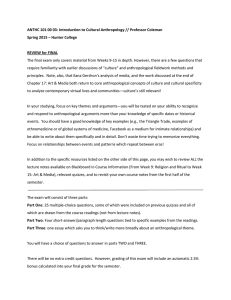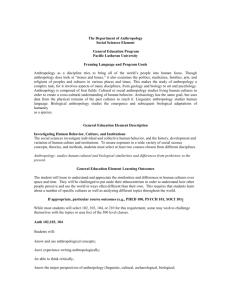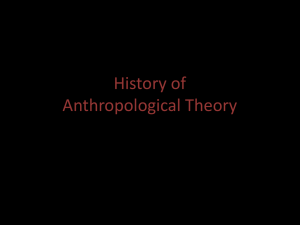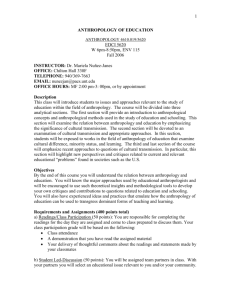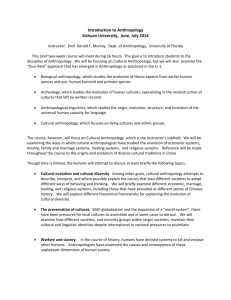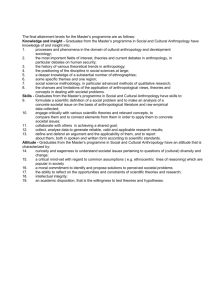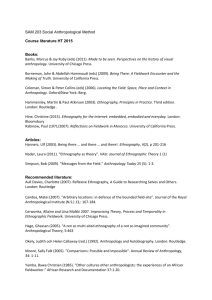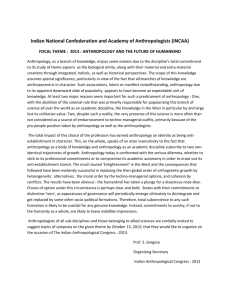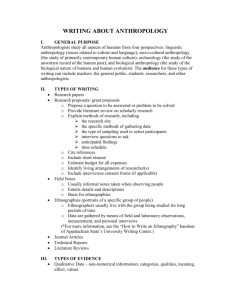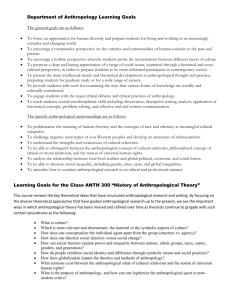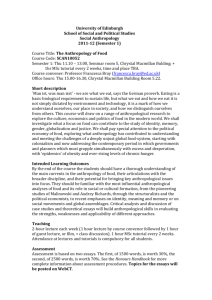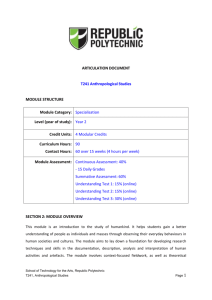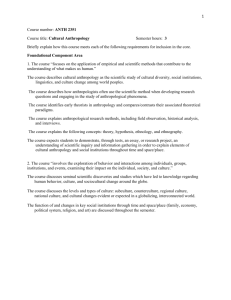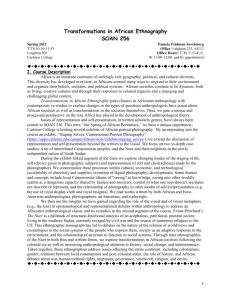Proposal
advertisement
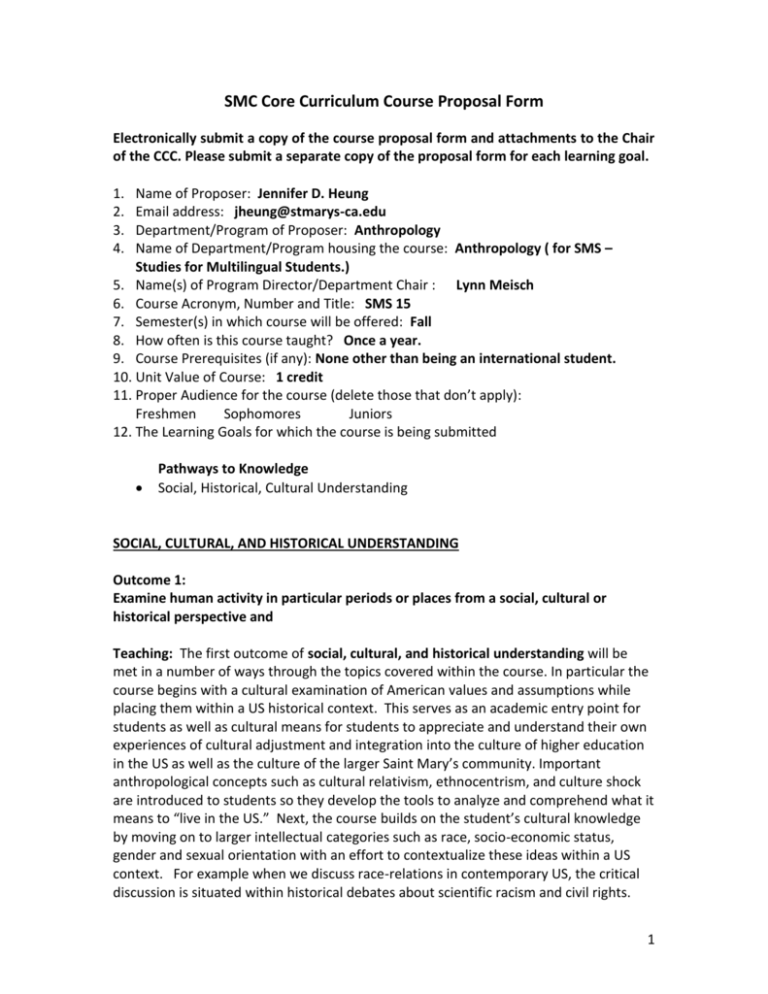
SMC Core Curriculum Course Proposal Form Electronically submit a copy of the course proposal form and attachments to the Chair of the CCC. Please submit a separate copy of the proposal form for each learning goal. 1. 2. 3. 4. Name of Proposer: Jennifer D. Heung Email address: jheung@stmarys-ca.edu Department/Program of Proposer: Anthropology Name of Department/Program housing the course: Anthropology ( for SMS – Studies for Multilingual Students.) 5. Name(s) of Program Director/Department Chair : Lynn Meisch 6. Course Acronym, Number and Title: SMS 15 7. Semester(s) in which course will be offered: Fall 8. How often is this course taught? Once a year. 9. Course Prerequisites (if any): None other than being an international student. 10. Unit Value of Course: 1 credit 11. Proper Audience for the course (delete those that don’t apply): Freshmen Sophomores Juniors 12. The Learning Goals for which the course is being submitted Pathways to Knowledge Social, Historical, Cultural Understanding SOCIAL, CULTURAL, AND HISTORICAL UNDERSTANDING Outcome 1: Examine human activity in particular periods or places from a social, cultural or historical perspective and Teaching: The first outcome of social, cultural, and historical understanding will be met in a number of ways through the topics covered within the course. In particular the course begins with a cultural examination of American values and assumptions while placing them within a US historical context. This serves as an academic entry point for students as well as cultural means for students to appreciate and understand their own experiences of cultural adjustment and integration into the culture of higher education in the US as well as the culture of the larger Saint Mary’s community. Important anthropological concepts such as cultural relativism, ethnocentrism, and culture shock are introduced to students so they develop the tools to analyze and comprehend what it means to “live in the US.” Next, the course builds on the student’s cultural knowledge by moving on to larger intellectual categories such as race, socio-economic status, gender and sexual orientation with an effort to contextualize these ideas within a US context. For example when we discuss race-relations in contemporary US, the critical discussion is situated within historical debates about scientific racism and civil rights. 1 This framework then informs how we understand the cultural construction of race and furthermore international students are encouraged to examine their own cultures’ attitudes on race. From this anthropological approach, students become aware of both insider (emic) and outsider (etic) perspectives. Other topics such as socio-economic status and gender are conceptualized and presented in a similar manner. Learning: This learning outcome is measured by quizzes and student presentations in class. Quizzes are usually 1-2 pages with short answer questions that cover basic information about the readings (main points and central argument of a reading, key concepts, etc) and ask students to articulate how class topics are approached within the discipline of anthropology. Aspects of this learning outcome will also be measured in the exams to determine if there are higher levels of understanding in terms students ability to describe and speak about specific forms of human activity in relation to their appropriate social, cultural and historical context. Outcome 2: Demonstrate an understanding of theories of human behavior, relations, culture, or institutions; or interpretations of historical causation and change; and Teaching: The second core learning outcome under Social, Cultural, and Historical Understanding is achieved through the reading of articles that deal with American culture and ethnographic readings that highlight the diverse values of American culture. Course readings introduce different American cultural values and assumptions, which include concepts such as individualism, freedom, and privacy to understand different theories regarding cultural change and continuation. Different examples of how these values manifest within American culture will be discussed to understand how these ideas shape and influence individual behaviors as well as larger social structures such as school systems or consumer markets. For example, the students read several articles about courtship and marriage in the US. Through discussion, the class identifies specific behaviors in courtship that are motivated by the concepts of individualism, freedom and privacy. Next, the class reads additional articles about courtship and marriage in other cultures so comparisons can be made to understand cross-cultural diversity when analyzing a single topic. Finally the larger historical context of individualism, freedom, and privacy (in this case, as they pertain to courtship and marriage) are contextualized within larger cultural and historical processes such as feminism, gay rights, and colonialism. Through discussions and written critical reflections, students examine these processes of causation and change within the context of race, class, gender, and sexuality. Again in these discussions, students are encouraged to draw from their own cultural background, which can be quite different from the American values we have been discussing. Through these discussion students will learn how to articulate and identify the different factors that contribute to the formations or changes of different American values they are studying and describing. 2 Learning: The second core learning outcome under Social, Cultural, and Historical Understanding is measured by critical reflections, discussions, and exams, where students will have ample opportunity to demonstrate their understanding of the different socio-cultural, economic, and political processes examined during the academic semester. In producing critical reflections as well as responding to specific questions on exams, students will be asked to apply their understanding of concepts to specific theories such as the enculturation process, assumptions made in high-context cultures vs. low-context cultures, how power is maintained through racial hierarchies, etc. Exams (midterm and final) will include multiple choice, fill-in responses, short answers, and long essays, which are all used to test the student’s knowledge, comprehension and application of anthropological concepts, theories and perspectives. Outcome 3: Employ social science or historical methodology to collect and interpret evidence about the social world. Teaching: Anthropology uses a number of different methodologies to interpret evidence about the social world and during this course, students are introduced to and directed to employ different methodologies to identify, analyze and evaluate different cultural concepts and phenomenon. The methodologies covered in this course include: participant observation, media and historical analysis, interviewing techniques, and cross-cultural comparison. Participant observation is a primary method of research used in cultural anthropology and involves the researcher living within a given culture for an extended period of time to gain familiarity and to take part in its daily life. In doing so, one is able to experience the richness and diversity of any given culture. As international students, they practice participant observation everyday by being enrolled at an US institution. This course directs students towards becoming increasingly aware of their own practice of participant observation while living in the United States. Naturally, these comparisons are cross-cultural in nature since international students will notice differences between US cultural constructs and their home country’s cultural ideals. Additionally, through class discussions, readings, and critical reflection assignments, students gain the skills that allow them to identify and articulate cultural concepts as well as the ability to analyze and interpret their own experiences of different cultural events. Media and historical analysis is used as students learn to contextualize cultural concepts and phenomenon within their cultural, social, political, and historical circumstances. For example students may first explore gender expectations as depicted in newspapers and magazines within the US, then identify larger historical and social trends regarding gender expectations, and finally move towards a larger cross-cultural comparison as students generate and evaluate different interpretations between two cultures such as the US and China. 3 Learning: This final outcome regarding methodology and interpretation under Social, Cultural, and Historical Understanding will be measured specifically by two assignments: 1) a “Current Issue in US Culture” assignment, where students will work independently in locating and analyzing a collection of newspaper clippings about one topic salient to American culture; 2) a oral history interview where students will practice employing anthropological methods such as taking fieldnotes, observations, and interview techniques. With the “Current Issues” assignment, student will have the opportunity to exercise interpretation skills with evidence that is collected from current news media. The newspaper articles encourage international students to develop an interest in the world around them through an anthropological lens. After collecting their own cultural data, students will analyze the content and identify larger patterns and key concepts related to their chosen topic. Students’ ability to interpret will be assessed by their effectiveness in explaining how the data they collected stem from and are linked to larger social and historical processes such as globalization or colonialism. The ability to move from the micro (for example personal experiences of racism) to the macro (being able to contextualize personal experiences as examples of larger processes of inequality which have created and are structured by ideas of race) will demonstrate students’ ability to effectively interpret data. This final paper is 4-5 pages and requires student to discuss their methodology as well as explicitly link three or more anthropological concepts to their analysis. The second assignment, Life History Collection, requires a student to create a set of interview questions about different themes regarding life in the US and then interview an individual. Interview questions are organized by themes such as gender, work, or family. The final product is a written paper that presents an overview of an individual’s life and the important events that shaped his or her worldview. Ultimately, both these writing assignments are opportunities for students to demonstrate how they interpret evidence from the social world. Before the final assignments are due there will also be class discussion regarding the data student have collected. This allows students to learn from each other and to practice critical interpretations in preparation for their final draft, which serves as a formal assessment of the student’s learning. 4
